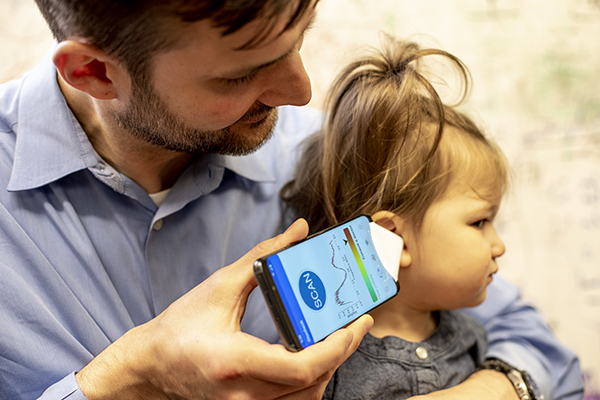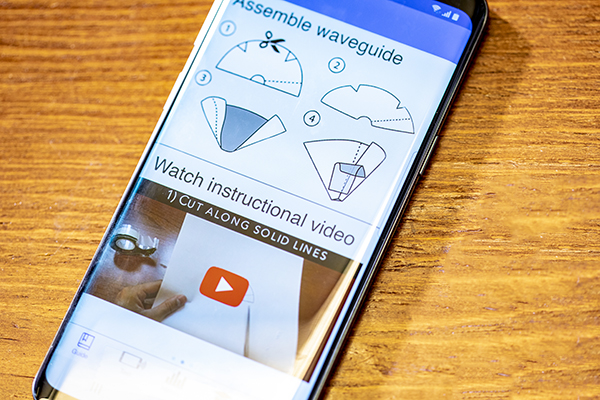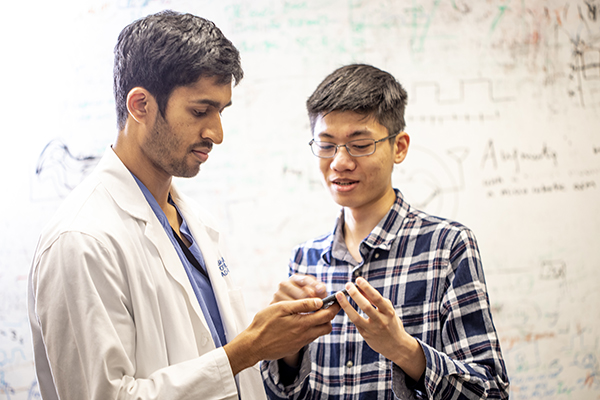
Researchers in the Allen School and UW Medicine have come up with a novel way to determine whether children may be suffering from an ear infection with the help of a smartphone and a piece of paper. In a paper published last week in the journal Science Translational Medicine, the team presents a new app that can detect the presence of fluid behind a child’s eardrum — a telltale sign of infection — anytime, anywhere in a matter of seconds using a smartphone’s microphone and speaker.
It’s a development that is sure to be music to parents’ ears. And given that the software can be used on virtually any smartphone without the need for specialized equipment, the app’s potential should resonate with providers, as well.
“Designing an accurate screening tool on something as ubiquitous as a smartphone can be game changing for parents as well as health care providers in resource-limited regions,” professor Shyam Gollakota, director of the Allen School’s Networks & Mobile Systems Laboratory, said in a UW News release. “A key advantage of our technology is that it does not require any additional hardware other than a piece of paper and a software app running on the smartphone.”
As Gollakota and his co-authors point out, acute otitis media (AOM) — the condition commonly referred to as an “ear infection” — is a leading cause of pediatric healthcare visits. Fluid in the ear can indicate a child has AOM or otitis media with effusion (OME), a condition in which fluid is present without an acute infection. The latter affects up to 80 percent of children and increases their chances of developing AOM in addition to other complications. Current methods for determining the presence of middle ear fluid, such as pneumatic otoscopy, require a visit to the doctor’s office, but is used by less than one-third of providers; tympanometry requires a referral to an audiologist and relies on expensive, specialized equipment.
For a more convenient — and less costly — solution, the UW team applied the concept of acoustic reflectometry to build a smartphone app that detects the presence of fluid by tapping into the eardrum’s response to sound waves. The researchers take advantage of the co-located microphone and speaker configuration already built into widely available smartphone models to provide a mobile software-based solution, thus negating the need for a separate device. To initiate the test, a user takes a simple, do-it-yourself paper funnel cut from a pattern and affixes it to the smartphone’s speaker. The funnel is placed at the entrance to the outer ear, enabling the phone to emit a series of soft, bird-like chirping sounds into the ear canal. The sound waves from the chirps cause the eardrum to vibrate to varying degrees, depending on whether fluid is present. Those vibrations are then reflected back to the app, which measures the resulting interference with the chirps.
The vibration of a normal eardrum generates a broad-spectrum, soft echo. The presence of fluid, however, restricts the vibration of the eardrum, reflecting sound waves back along the ear canal in a manner that creates more destructive interference. By measuring this interference, the app alerts the user whether fluid — and potentially, infection — is present inside the ear. As Allen School Ph.D. student Justin Chan, co-lead author of the paper, explained, the concept is similar to the different tone one gets from tapping a drinking glass. “Depending on how much liquid is in it, you get different sounds,” he noted. “Using machine learning on these sounds, we can detect the presence of liquid.”
Gollakota and Chan worked with Allen School Ph.D. student Rajalakshmi Nandakumar and physicians Sharat Raju and Randall Bly of UW Medicine on the project. The researchers trained the algorithm that powers their app with data collected from 53 children undergoing surgery at Seattle Children’s Hospital, where Bly practices, with parental consent. Nearly half of the patients, who ranged from 18 months to 17 years of age, were scheduled for a myringotomy, a common procedure to address recurring ear infections in which a small, plastic tube is inserted into the eardrum to prevent a future build-up of fluid in the middle ear. The other patients were undergoing procedures for conditions unrelated to the ear and showed no signs of having middle ear fluid. Each of the 98 patient ears tested with the smartphone app were also tested using a commercially available acoustic reflectometry device for comparison.
The team demonstrated the app could correctly identify the presence or absence of fluid 85 percent of the time, a rate of accuracy comparable to that of standard methods. The researchers also showed that, with minimal training, parents and caregivers can perform the test on any smartphone with a DIY funnel made out of any type of paper — proving that their new app offers a sound approach for screening at home or on the go.

“The medical community has recognized the need for a more efficient yet reliable screening for middle ear fluid in children,” noted Gollakota. “The community also called for new strategies for monitoring fluid at home following a physician’s exam. Our app provides a way to do both, helping to speed diagnosis and improve patient outcomes for two of the most common pediatric ear diseases.”
Gollakota and his collaborators will commercialize their work through a new UW spinout company, Edus Health, with the goal of putting the app in the hands of parents and providers around the world.
Read the journal paper here, UW News release here, and National Science Foundation release here. Check out coverage by NPR, Associated Press, US News & World Report, CNBC, GeekWire, STAT News, New Scientist, Gizmodo, Digital Trends, New Atlas, MobiHealth News, and Mental Floss.



